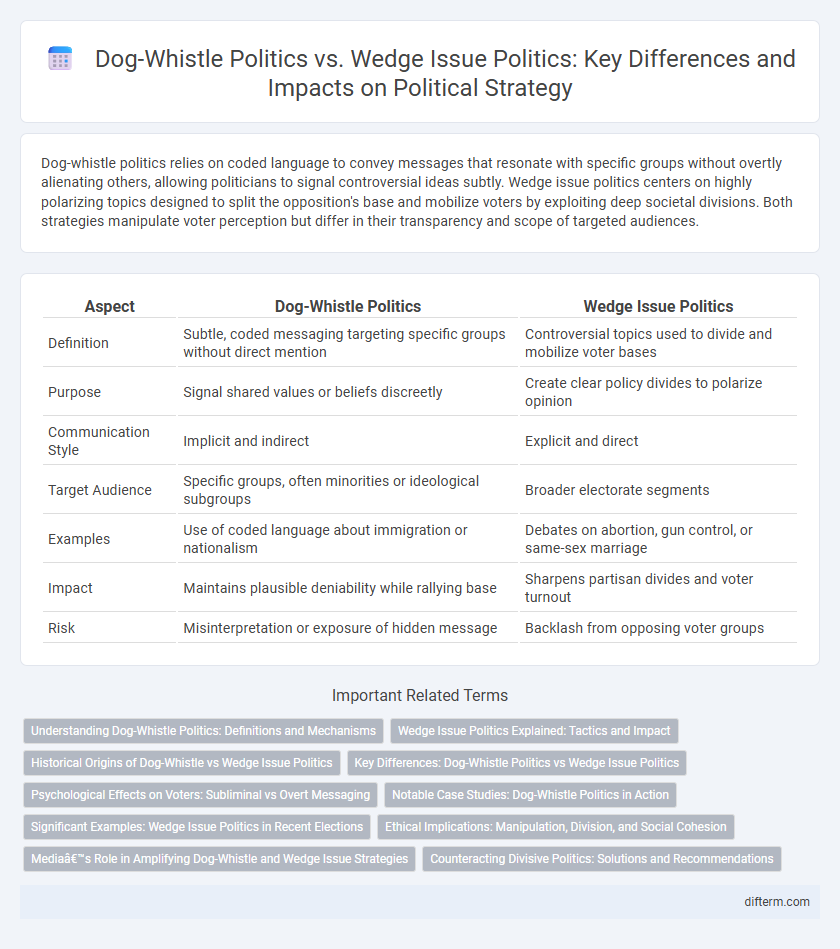Dog-whistle politics relies on coded language to convey messages that resonate with specific groups without overtly alienating others, allowing politicians to signal controversial ideas subtly. Wedge issue politics centers on highly polarizing topics designed to split the opposition's base and mobilize voters by exploiting deep societal divisions. Both strategies manipulate voter perception but differ in their transparency and scope of targeted audiences.
Table of Comparison
| Aspect | Dog-Whistle Politics | Wedge Issue Politics |
|---|---|---|
| Definition | Subtle, coded messaging targeting specific groups without direct mention | Controversial topics used to divide and mobilize voter bases |
| Purpose | Signal shared values or beliefs discreetly | Create clear policy divides to polarize opinion |
| Communication Style | Implicit and indirect | Explicit and direct |
| Target Audience | Specific groups, often minorities or ideological subgroups | Broader electorate segments |
| Examples | Use of coded language about immigration or nationalism | Debates on abortion, gun control, or same-sex marriage |
| Impact | Maintains plausible deniability while rallying base | Sharpens partisan divides and voter turnout |
| Risk | Misinterpretation or exposure of hidden message | Backlash from opposing voter groups |
Understanding Dog-Whistle Politics: Definitions and Mechanisms
Dog-whistle politics involves coded language or subtle signals targeting specific groups without overtly offending others, enabling politicians to convey controversial messages indirectly. This strategy relies on ambiguities and shared knowledge within particular audiences to mobilize support while maintaining plausible deniability. Understanding these mechanisms is crucial for recognizing how dog-whistle tactics manipulate political discourse by exploiting social divisions and underlying prejudices.
Wedge Issue Politics Explained: Tactics and Impact
Wedge issue politics exploit deep-seated social and cultural divisions by introducing controversial topics to split the opposition's voter base, thus strengthening the initiating party's support. Common tactics include emphasizing contentious subjects such as immigration, gun control, or abortion to polarize public opinion and force fractures within rival coalitions. The impact often results in heightened political polarization, reduced bipartisan cooperation, and a shift in electoral strategies prioritizing identity and emotional appeal over policy nuance.
Historical Origins of Dog-Whistle vs Wedge Issue Politics
Dog-whistle politics originated during the late 20th century as coded language aimed at appealing to specific ideological groups without overt expression, particularly in the context of racial and social issues in the United States. Wedge issue politics trace back to mid-20th-century strategies where parties exploited divisive social topics, such as civil rights and abortion, to fracture opposition coalitions and consolidate their voter base. Both tactics manipulate public opinion but differ in subtlety and directness, with dog-whistles relying on hidden cues and wedge issues on overt polarizing debates.
Key Differences: Dog-Whistle Politics vs Wedge Issue Politics
Dog-whistle politics relies on coded language to subtly signal messages to a particular group without overtly alienating others, enabling politicians to convey controversial ideas indirectly. Wedge issue politics involves openly polarizing topics designed to split the opposing party's voter base by creating internal conflicts around divisive social or policy issues. The key difference lies in dog-whistle politics' subtlety and ambiguity versus wedge issue politics' explicit exploitation of deep societal divisions for strategic advantage.
Psychological Effects on Voters: Subliminal vs Overt Messaging
Dog-whistle politics employs subliminal messaging targeting specific voter groups through coded language that triggers subconscious biases, reinforcing identity and group loyalty without overt recognition. In contrast, wedge issue politics uses explicit, polarizing topics that create clear divisions among voters, provoking strong emotional reactions and mobilizing turnout through direct confrontation. These psychological effects influence voter behavior by subtly shaping attitudes in dog-whistle tactics while provoking immediate, conscious responses in wedge issue strategies.
Notable Case Studies: Dog-Whistle Politics in Action
Dog-whistle politics strategically employs coded language to signal specific messages to targeted groups without attracting wider scrutiny, as seen in the 1988 U.S. presidential campaign when George H.W. Bush used the phrase "Willie Horton" to evoke racial fears among voters. The 2016 Brexit referendum also showcased dog-whistle tactics, with vague appeals to immigration concerns tapping into nationalist sentiments without explicit inflammatory rhetoric. These cases highlight how dog-whistle politics manipulates underlying social anxieties while maintaining plausible deniability in public discourse.
Significant Examples: Wedge Issue Politics in Recent Elections
Wedge issue politics prominently shaped the 2016 U.S. presidential election with topics like immigration reform and gun control sharply dividing voter bases. In Australia's 2019 federal election, the debate over climate policy created significant voter polarization, highlighting wedge strategies. These examples demonstrate how targeted divisive issues mobilize core supporters while fragmenting opposition coalitions in contemporary electoral politics.
Ethical Implications: Manipulation, Division, and Social Cohesion
Dog-whistle politics exploits coded language to subtly manipulate targeted groups while maintaining plausible deniability, raising profound ethical concerns about transparency and honesty in democratic discourse. Wedge issue politics deliberately amplifies societal divisions by polarizing public opinion on contentious topics, eroding social cohesion and trust among communities. Both strategies undermine ethical governance by prioritizing political gain over inclusive dialogue and long-term social stability.
Media’s Role in Amplifying Dog-Whistle and Wedge Issue Strategies
Media outlets amplify dog-whistle politics by selectively highlighting coded language that resonates with specific voter bases without overt expression, thereby intensifying partisan divides. Wedge issue politics gain traction through sensationalized coverage, framing divisive topics to polarize public opinion and deepen societal fractures. The continuous cycle of media amplification not only reinforces these strategies but also shapes political discourse by prioritizing conflict over consensus.
Counteracting Divisive Politics: Solutions and Recommendations
Counteracting divisive politics requires promoting transparent communication that discourages coded language and exposes dog-whistle tactics undermining social cohesion. Implementing inclusive dialogue platforms helps address wedge issues by fostering mutual understanding and reducing polarization within communities. Strengthening media literacy programs empowers citizens to critically evaluate political messages and resist manipulation through divisive strategies.
Dog-whistle politics vs Wedge issue politics Infographic

 difterm.com
difterm.com